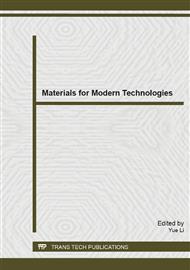[1]
A. Greco, R. Gennaro, A. Timo, F. Bonfantini, A. Maffezzoli, A Comparative Study Between Bio-composites Obtained with Opuntia ficus indica Cladodes and Flax Fibers, J. Polym. Environ. 21(4), 910-916 (2013).
DOI: 10.1007/s10924-013-0595-x
Google Scholar
[2]
Yasemin Bulut, Aysun Aksit, A comparative study on chemical treatment of jute fiber: potassium dichromate, potassium permanganate and sodium perborate trihydrate, Cellulose, 20(6), 3155-3164 (2013).
DOI: 10.1007/s10570-013-0049-6
Google Scholar
[3]
A. Hakamy, F. U. A. Shaikh, I. M. Low, Thermal and mechanical properties of hemp fabric-reinforced nanoclay–cement nanocomposites, J. Mater. Sci. 49(4), 1684-1694(2014).
DOI: 10.1007/s10853-013-7853-0
Google Scholar
[4]
Hae Young Choi, Jung Soon Lee, Effects of surface treatment of ramie fibers in a ramie/poly(lactic acid) composite, Fiber. Polym. 13(2), 217-223(2012).
DOI: 10.1007/s12221-012-0217-6
Google Scholar
[5]
Ebru Bozaci, Kutlay Sever, Asli Demir, Yoldas Seki, Mehmet Sarikanat, Esen Ozdogan, Effect of the atmospheric plasma treatment parameters on surface and mechanical properties of jute fabric, Fiber. Polym. 10(6), 781-786(2009).
DOI: 10.1007/s12221-009-0781-6
Google Scholar
[6]
Chuanwei Miao, Wadood Y. Hamad, Cellulose reinforced polymer composites and nanocomposites: a critical review, Cellulose, 20(5), 2221-2262(2013).
DOI: 10.1007/s10570-013-0007-3
Google Scholar
[7]
Arnold N. Towo, Martin P. Ansell, Fatigue evaluation and dynamic mechanical thermal analysis of sisal fibre–thermosetting resin composites, Compos. Sci. Technol. 68(2008) 925-932.
DOI: 10.1016/j.compscitech.2007.08.022
Google Scholar
[8]
C.P.L. Chow, X.S. Xing, R.K.Y. Li, Moisture absorption studies of sisal fibre reinforced polypropylene composites, Compos. Sci. Technol. 67(2007) 306-313.
DOI: 10.1016/j.compscitech.2006.08.005
Google Scholar
[9]
Yan Li, Chunjing Hu, Yehong Yu, Interfacial studies of sisal fiber reinforced high density polyethylene (HDPE) composites, Compos. Part A-Appl. S. 39(4), 570-578 (2008).
DOI: 10.1016/j.compositesa.2007.07.005
Google Scholar
[10]
Suk Hyang Yun, Donghwan Cho, Effect of silane coupling agents with different organo-functional groups on the interfacial shear strength of glass fiber/Nylon 6 composites, J. Mater. Sci. Lett. 22(22), 1591-1594(2003).
Google Scholar
[11]
P.V. Joseph, Marcelo S. Rabello, L.H.C. Mattoso, Kuruvilla Joseph and Sabu Thomas, Environmental effects on the degradation behaviour of sisal fibre reinforced polypropylene composites, Compos. Sci. Technol. 62(10-11) 1357-1372 (2002).
DOI: 10.1016/s0266-3538(02)00080-5
Google Scholar
[12]
C. Albano, J. Reyes, M. Ichazo, J. Gonzalez, M. Brito, D. Moronta, Analysis of the mechanical, thermal and morphological behaviour of polypropylene compounds with sisal fibre and wood flour, irradiated with gamma rays, Polym. Degrad. Stabil. 76 (2), 191-203 (2002).
DOI: 10.1016/s0141-3910(02)00014-9
Google Scholar
[13]
P.V. Joseph, G. Mathew, K. Joseph, G. Groeninckx, S. Thomas, Mechanical properties of short sisal fiber-reinforced polypropylene composites: Comparison of experimental data with theoretical predictions, J. Appl. Polym. Sci. 88(3), 602-622 (2003).
DOI: 10.1002/app.11498
Google Scholar
[14]
L. M. Arzondo, A. Vazquez, J. M. Carella and J. M. Pastor, A low-cost, low-fiber-breakage, injection molding process for long sisal fiber reinforced polypropylene, Polym. Eng. Sci. 44(9), 1766-1772 (2004).
DOI: 10.1002/pen.20178
Google Scholar
[15]
Smita Mohanty, Sushil K. Verma, Sanjay K. Nayak, Sudhansu S. Tripathy, Influence of fiber treatment on the performance of sisal–polypropylene composites, J. Appl. Polym. Sci. 94(3), 1336-1345 (2004).
DOI: 10.1002/app.21161
Google Scholar
[16]
L.T. Drzal, M. Madhukar, Fibre-matrix adhesion and its relationship to composite mechanical properties, J. Mater. Sci. 28(3), 569-610 (1993).
DOI: 10.1007/bf01151234
Google Scholar
[17]
O. Brovko, P. Rosso, K. Friedrich, Adhesion between differently treated fibers and a hybrid resin system, J. Mater. Sci. Lett. 21(4), 305-308 (2002).
Google Scholar
[18]
L. Y. Mwaikambo and M. P. J. Ansell, The determination of porosity and cellulose content of plant fibers by density methods, J. Mater. Sci. Lett. 20(23), 2095-2096 (2001).
Google Scholar
[19]
P. Hedenberg, Licentiate Thesis, Chalmers University of Technology, Goteborg, Sweden, (1996).
Google Scholar
[20]
L.Y. Mwaikambo, M.P. Ansell, Chemical modification of hemp, sisal, jute, and kapok fibers by alkalization, J. Appl. Polym. Sci. 84(12), 2222-2234 (2002).
DOI: 10.1002/app.10460
Google Scholar
[21]
Ying Li, Xi-Shu Wang , Qinshan Fan, Effects of elastic anisotropy on the surface stability of thin film/substrate system, Int. J. Eng. Sci. 46(12), 1325-1333 (2008).
DOI: 10.1016/j.ijengsci.2008.07.008
Google Scholar
[22]
G. Désarmot, J. P. Favre, Advances in pull-out testing and data analysis, Compos. Sci. Technol. 42(1-3), 151-187 (1991).
Google Scholar
[23]
M.R. Piggott, A new model for interface failure in fibre-reinforced polymers, Compos. Sci. Technol. 55(3), 269-276 (1995).
Google Scholar
[24]
JianXin Li, Analysis of the pullout of single fibers from low-density polyethylene, J. Appl. Polym. Sci. 53(2), 225-237 (1994).
DOI: 10.1002/app.1994.070530211
Google Scholar


